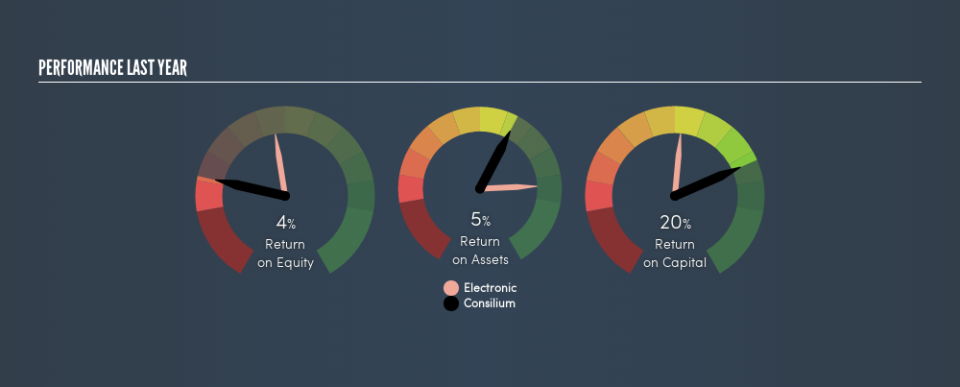What Can We Make Of Consilium AB (publ)’s (STO:CONS B) High Return On Capital?

Want to participate in a short research study? Help shape the future of investing tools and you could win a $250 gift card!
Today we'll evaluate Consilium AB (publ) (STO:CONS B) to determine whether it could have potential as an investment idea. Specifically, we'll consider its Return On Capital Employed (ROCE), since that will give us an insight into how efficiently the business can generate profits from the capital it requires.
First of all, we'll work out how to calculate ROCE. Second, we'll look at its ROCE compared to similar companies. Last but not least, we'll look at what impact its current liabilities have on its ROCE.
Return On Capital Employed (ROCE): What is it?
ROCE is a measure of a company's yearly pre-tax profit (its return), relative to the capital employed in the business. All else being equal, a better business will have a higher ROCE. In brief, it is a useful tool, but it is not without drawbacks. Renowned investment researcher Michael Mauboussin has suggested that a high ROCE can indicate that 'one dollar invested in the company generates value of more than one dollar'.
So, How Do We Calculate ROCE?
Analysts use this formula to calculate return on capital employed:
Return on Capital Employed = Earnings Before Interest and Tax (EBIT) ÷ (Total Assets - Current Liabilities)
Or for Consilium:
0.20 = kr127m ÷ (kr2.0b - kr1.4b) (Based on the trailing twelve months to March 2019.)
Therefore, Consilium has an ROCE of 20%.
View our latest analysis for Consilium
Does Consilium Have A Good ROCE?
ROCE can be useful when making comparisons, such as between similar companies. Consilium's ROCE appears to be substantially greater than the 14% average in the Electronic industry. We would consider this a positive, as it suggests it is using capital more effectively than other similar companies. Setting aside the comparison to its industry for a moment, Consilium's ROCE in absolute terms currently looks quite high.
In our analysis, Consilium's ROCE appears to be 20%, compared to 3 years ago, when its ROCE was 13%. This makes us think about whether the company has been reinvesting shrewdly.
When considering ROCE, bear in mind that it reflects the past and does not necessarily predict the future. ROCE can be deceptive for cyclical businesses, as returns can look incredible in boom times, and terribly low in downturns. ROCE is only a point-in-time measure. Future performance is what matters, and you can see analyst predictions in our free report on analyst forecasts for the company.
What Are Current Liabilities, And How Do They Affect Consilium's ROCE?
Short term (or current) liabilities, are things like supplier invoices, overdrafts, or tax bills that need to be paid within 12 months. The ROCE equation subtracts current liabilities from capital employed, so a company with a lot of current liabilities appears to have less capital employed, and a higher ROCE than otherwise. To check the impact of this, we calculate if a company has high current liabilities relative to its total assets.
Consilium has total assets of kr2.0b and current liabilities of kr1.4b. As a result, its current liabilities are equal to approximately 68% of its total assets. Consilium boasts an attractive ROCE, even after considering the boost from high current liabilities.
The Bottom Line On Consilium's ROCE
So to us, the company is potentially worth investigating further. There might be better investments than Consilium out there, but you will have to work hard to find them . These promising businesses with rapidly growing earnings might be right up your alley.
I will like Consilium better if I see some big insider buys. While we wait, check out this free list of growing companies with considerable, recent, insider buying.
We aim to bring you long-term focused research analysis driven by fundamental data. Note that our analysis may not factor in the latest price-sensitive company announcements or qualitative material.
If you spot an error that warrants correction, please contact the editor at editorial-team@simplywallst.com. This article by Simply Wall St is general in nature. It does not constitute a recommendation to buy or sell any stock, and does not take account of your objectives, or your financial situation. Simply Wall St has no position in the stocks mentioned. Thank you for reading.


